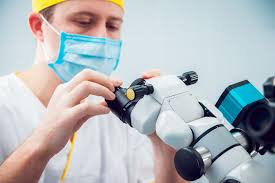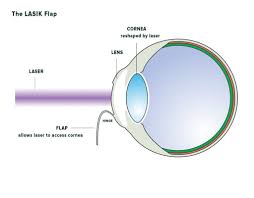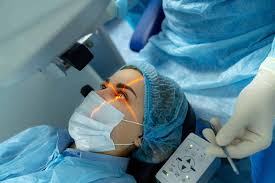Table of Contents
ToggleThe cells growing in your eyes after LASIK, mainly corneal epithelial cells and keratocytes, are essential for healing and repair.
However, in rare cases, abnormal cell growth may occur, leading to conditions like epithelial ingrowth.
LASIK is a popular and effective procedure for correcting vision, but like any surgery, it requires a healing period. During this time, your eyes undergo various changes, including cellular activity that facilitates recovery. Understanding these changes can help you manage expectations and identify when additional medical attention may be necessary.

How Does LASIK Affect Your Eye Cells?
LASIK involves reshaping the cornea to improve vision. During the procedure, a flap is created in the cornea, and the underlying tissue is reshaped using a laser. This process disrupts the natural structure of the cornea, stimulating the cells to begin a healing and regenerative response.
- Corneal Epithelial Cells
These cells form the outermost layer of your cornea and act as a protective barrier. After LASIK, they rapidly regenerate to repair the flap created during the surgery. This process typically takes a few days to a week.
- Keratocytes
Found in the stroma (middle layer of the cornea), keratocytes are responsible for producing collagen and extracellular matrix to support corneal structure. After LASIK, they become activated to aid in wound healing.
- Nerve Regeneration
LASIK also affects the corneal nerves, which regulate tear production and sensation. Nerve regrowth is a gradual process that may take months or even a year to fully resolve.
The growth and interaction of these cells are part of the normal recovery process. However, in some cases, abnormal cell behaviour may occur, leading to complications.
What is Epithelial Ingrowth?
Epithelial ingrowth is a condition where the epithelial cells grow underneath the corneal flap created during LASIK. While this is an uncommon complication, it’s essential to recognise the signs to ensure timely treatment.
Causes of Epithelial Ingrowth
- Poor adherence of the corneal flap
- Loose epithelial cells during the procedure
- Trauma or dislodging of the flap post-surgery
Symptoms of Epithelial Ingrowth
- Blurred vision
- Light sensitivity
- Discomfort or foreign body sensation
- Increased tearing
How is Epithelial Ingrowth Treated?
Mild cases of epithelial ingrowth may not require treatment, as the cells can stabilise or regress over time. However, in moderate to severe cases, intervention is necessary to prevent damage to the cornea or vision loss.
Treatment typically involves lifting the corneal flap, removing the cells, and resealing the flap securely. Your surgeon may also prescribe eye drops to reduce inflammation and promote healing.
Other Cellular Changes After LASIK
While epithelial ingrowth is the most known cell-related complication, there are other cellular changes to be aware of post-LASIK:
Fibroblast Activation
Fibroblasts may become active during the healing process, contributing to scar tissue formation. This cellular activity is typically minimal, but excessive fibroblast activation can result in corneal haze, affecting vision clarity.
Keratocyte Death
After the procedure, some keratocytes die as part of the cornea’s natural response to injury. This is a normal occurrence and does not usually impact healing. The cornea compensates by activating surrounding keratocytes to maintain structural integrity.
Changes in Stromal Cells
The stromal cells in your cornea may adapt to the altered shape of the cornea after LASIK. This includes changes in their organisation and interaction to stabilise the corneal structure.
How to Promote Healthy Cell Growth After LASIK?
Your body has an incredible ability to heal itself, but ensuring optimal recovery after LASIK involves specific actions and precautions. Here’s how you can support healthy cell growth:
Follow Post-Operative Care Instructions
Adhering to your surgeon’s instructions is crucial. This includes using prescribed eye drops to prevent infection and reduce inflammation, avoiding rubbing your eyes, and protecting your eyes with sunglasses.
Stay Hydrated
Dehydration can slow the healing process, as your cells rely on adequate hydration to function properly. Aim to drink plenty of water throughout the day.
Use Artificial Tears
LASIK may temporarily impair tear production, resulting in dryness of the eyes. Using preservative-free artificial tears helps keep your eyes moist and supports the regeneration of epithelial cells.
Avoid Straining Your Eyes
Limit screen time and avoid activities that strain your eyes, such as reading in low light or prolonged use of digital devices. This prevents irritation and supports proper healing.
Attend Follow-Up Appointments
Regular check-ups with your surgeon are essential for monitoring the healing process. They can detect any abnormal cell growth early and address it promptly.
When to Seek Medical Attention?
While most LASIK patients experience a smooth recovery, complications can arise. It’s important to know when to contact your eye surgeon:
- Persistent discomfort or pain that does not improve with prescribed medication
- Sudden changes in vision, such as halos, glare, or blurred vision
- Signs of infection, including redness, swelling, or discharge
- Symptoms of epithelial ingrowth, such as light sensitivity or a foreign body sensation
Timely intervention can prevent potential complications and ensure the best possible outcome.
Understanding Long-Term Cellular Changes
LASIK is designed to provide lasting vision correction, but your cornea continues to adapt over time. Long-term cellular changes include the ongoing organisation of stromal cells and the stabilisation of nerve regrowth. These changes generally enhance the durability and effectiveness of the procedure.
It’s worth noting that certain lifestyle factors, such as UV exposure and general eye health, can impact the longevity of LASIK results. Wearing sunglasses and maintaining regular eye check-ups contribute to maintaining healthy eyes.
Key Takeaways
- The cells growing in your eyes after LASIK include corneal epithelial cells and keratocytes, essential for healing and regeneration.
- Abnormal cell growth, such as epithelial ingrowth, is a rare but manageable complication.
- Post-operative care, hydration, and follow-up appointments are crucial for promoting healthy cell growth.
- Understanding these cellular changes empowers you to take proactive steps towards recovery and sustained visual clarity.
LASIK is a life-changing procedure for many, offering improved vision and freedom from corrective lenses. By understanding the role of cellular activity in your recovery, you can approach the healing process with confidence and clarity. Always prioritise professional advice from your eye surgeon, and don’t hesitate to address any concerns during your follow-up visits.













